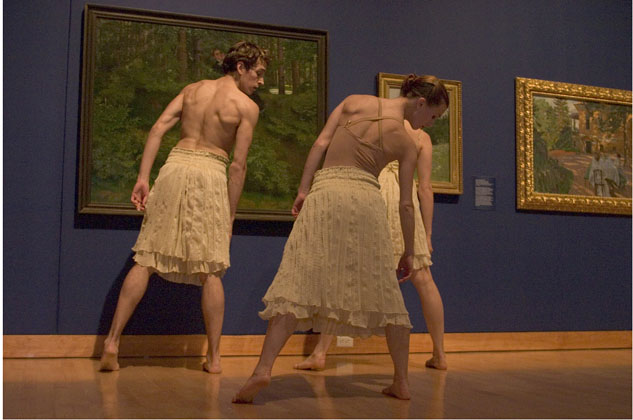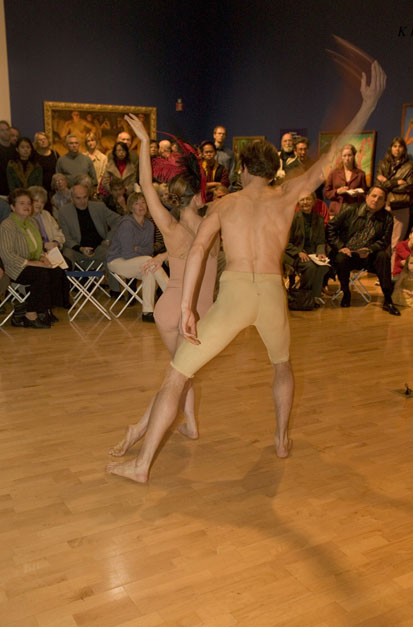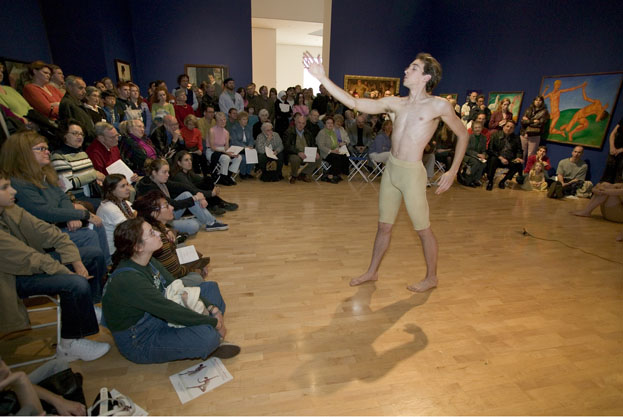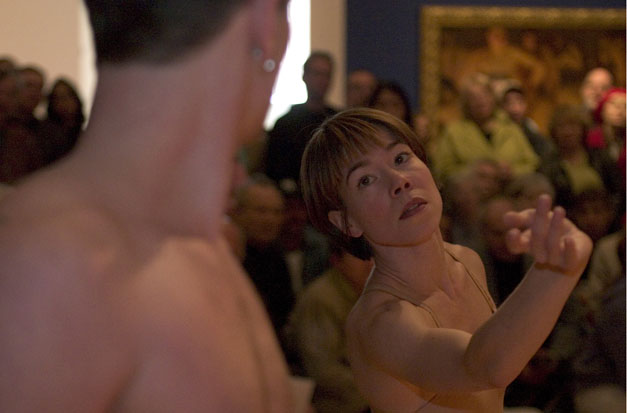The Idea of an Age: “Movement in Stillness” at the Weisman
Lightsey Darst saw "Movement in Stillness" (choreography by Penelope Freeh and Justin Leaf) at the Weisman Museum recently. This performance, part of the programming around the museum's current show of Russian art, was unusually revealing.





Imagine this scene:
Reclining in a blue dress and a Cubist setting, Anna Ahkmatova reads a poem, while in another room a lovely body enacts her words, curving and arching, the nearly nude flank and hip in constant and thoughtful motion. Picasso sketches, pens in the word “parade” at the top of the paper, and you have a new ballet, a set of characters, a new movement into the broad world.
Standing in a doorway, Diaghilev delivers his creed and followers join him, reading from now-weathered books, the words tumbling over each other until all you hear is “I worship beauty.” Nijinsky dances, Ballanchine and Alicia Markova dance in costumes by and before sets of Leon Bakst. Satie is writing music, Debussy is writing music. The time is gold-hung, like a precious icon, but languorous, like a Russian princess, and still strong-hearted, like a winter forest, and the bright faces flicker before you like veils, the thin bodies in their nude leotards bending and disappearing, but their words stay.
Painted sport-shaped bodies stand away from their canvas, defined in mental space, their strong arms standing on stage in place of the familiar tiny caresses. There is music by Stravinsky—the Rite of Spring—and the theater riots because it is not their parents’ music and not their parents’ dance but the performance goes on. It is a time of coming together: the unified arts will make a new world. It is a time of education: we must clear away the old, we must tell people what art really is. We are full of ideas, we are rich, we are young, we are shaking on the edge of revolution.
And yet I’ve never been interested in the Ballets Russes, in the art of pre-revolutionary Russia. Between me and that period is a block which I had always assumed was just preference on my part—until I saw Justin Leaf and Penelope Freeh recreating Nijinsky’s “Afternoon of a Faun” as another dancer read Marie Rambert’s commentary on the dance, all surrounded by paintings from the Weisman’s current exhibition of Russian art. The faun’s body positions are historical, strict as if carved on a wall; the dance is an idea; but it is also flesh, the living body manifesting an idea.
Seeing this old dance brought to life (and not in photographs, which never give the sense of motion), I understand why dance was so central to the arts then: it was the first ground to test what we could become. Dance performance was also the meeting place for the arts: Nijinsky created his “Afternoon of a Faun” to music that Debussy composed after a poem of Mallarme’s; the dance itself attempted to bring ancient bas-relief to life. Contrast this to the current “Faun” in favor, Jerome Robbins’s version, which (now that it has become standard) references only the ballet studio. This is the block between us and Nijinsky: we have a lot to learn before we approach him, and then we must be ready to learn more.
“Movement in Stillness” is unusual—an educational performance, with each capsule recreation accompanied by a reading about the dance. This is an ideal way to present dance history and also an interesting variation from the usual performance. The dance is mainly recreation; even Penelope Freeh’s delicious new piece (danced with wit and grace by Freeh and Nicholas Lincoln), choreographed from two paintings in the Mir Iskusstva exhibit, is an exercise in character—an obsession of that age and not a particular interest of this one. (Before Justin Leaf’s piece, unfortunately, the crowd moved and I was able to see only occasional fingertips and feet—though I could hear Run at the Dog’s finely embroidered music.)
Yet we need to be given the idea of this age if we are to create something like it again. One of the dancers read from Massine’s writing: “In 1918, we were mainly interested in creating something new and representative of our own age.” Massine might have added “representative of our own place,” for the art they created was grounded in Russia. In one moment from Leaf’s piece (which I was just able to see), dancers sat open-legged in front of paintings, looking up. Perhaps the symbolism is too obvious, but what if we, locally, did listen to each other’s paintings, write each other’s dancing? What is the art of our place and time?